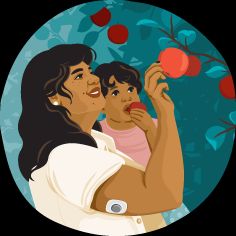What is a hypertensive emergency?
Hypertension, or high blood pressure, is a common condition. It affects
Guidelines for diagnosing and treating high blood pressure from the American College of Cardiology and American Heart Association have recently changed. Experts now predict that nearly half of American adults will have high blood pressure.
High blood pressure is diagnosed if one or both of the following occur:
- Your systolic blood pressure is consistently over 130.
- Your diastolic blood pressure is consistently over 80.
High blood pressure is generally manageable if you follow your doctor’s advice.
Although it’s not common, some people with high blood pressure may have a rapid rise in blood pressure above 180/120 millimeters of mercury (mm Hg). This is known as a hypertensive crisis.
If a person with a blood pressure of 180/120 mm Hg or higher also has new symptoms — especially those related to the eye, brain, heart, or kidney — this is known as a hypertensive emergency. Hypertensive emergencies were previously known, in some cases, as malignant hypertension.
A hypertensive emergency requires immediate medical attention. Symptoms indicate that organ damage is occurring. If you don’t get emergency treatment, you may develop serious health problems, such as:
A hypertensive emergency can also be life-threatening.
High blood pressure is commonly referred to as the “silent killer.” This is because it doesn’t always have obvious signs or symptoms. Unlike moderate high blood pressure, a hypertensive emergency has very noticeable symptoms. Symptoms can include:
- changes in vision, including blurred vision
- chest pain
- confusion
- nausea or vomiting
- numbness or weakness in the arms, legs, or face
- shortness of breath
- headache
- reduced urine output
A hypertensive emergency can also result in a condition known as hypertensive encephalopathy. This directly affects the brain. The symptoms of this disorder include:
Hypertensive emergencies mostly occur in people with a history of high blood pressure. It’s also more common in African-Americans, males, and people who smoke. It’s especially common in people whose blood pressure is already above 140/90 mm Hg. According to a 2012 clinical review, about 1 to 2 percent of people with high blood pressure develop hypertensive emergencies.
Some health conditions increase your chances of having a hypertensive emergency. These include:
- kidney disorders or kidney failure
- the use of drugs such as cocaine, amphetamines, birth control pills, or monoamine oxidase inhibitors (MAOIs)
- pregnancy
- preeclampsia, which is common after 20 weeks gestation, but can sometimes occur earlier in pregnancy or even postpartum
- autoimmune diseases
- spinal cord injuries causing parts of the nervous system to become overactive
- renal stenosis, which is a narrowing of the arteries of the kidneys
- a narrowing of the aorta, the main blood vessel leaving the heart
- not taking your medication for high blood pressure
If you have high blood pressure and develop any changes in your normal symptoms, seek immediate medical attention. Also seek immediate medical attention if you develop new symptoms related to a hypertensive emergency.
Your doctor will ask you about your health history, including any treatments you’re on for high blood pressure. They’ll also measure your blood pressure and discuss any symptoms you’re currently having, such as changes in vision, chest pain, or shortness of breath. This will help your doctor determine whether or not emergency treatment is needed.
Determining organ damage
Other tests may be used to see if your condition is causing organ damage. For instance, blood tests measuring blood urea nitrogen (BUN) and creatinine levels may be ordered.
The BUN test measures the amount of waste product from the breakdown of protein in the body. Creatinine is a chemical produced by the breakdown of muscles. Your kidneys clear it from your blood. When the kidneys aren’t functioning normally, these tests will have abnormal results.
Your doctor may also order the following:
- blood tests to check for a heart attack
- an echocardiogram or ultrasound to look at heart function
- a urine test to check kidney function
- an electrocardiogram (ECG or EKG) to measure the electrical functioning of the heart
- a renal ultrasound to look for additional kidney problems
- an eye exam to determine if damage to the eye has occurred
- a CT scan or MRI scan of the brain to check for bleeding or stroke
- a chest X-ray to look at the heart and lungs
A hypertension emergency can be life-threatening and requires immediate medical attention. You need to get treatment for it immediately in order to safely lower your blood pressure and avoid dangerous complications.
Treatment typically includes using high blood pressure medications, or antihypertensive medications, given intravenously, or through an IV. This allows for immediate action. You’ll typically require treatment in the emergency room and intensive care unit.
Once your blood pressure stabilizes, your doctor will prescribe oral blood pressure medications. These medications will enable you to control your blood pressure at home.
If you receive a diagnosis of a hypertensive emergency, you’ll need to follow your doctor’s recommendations. This will include having regular checkups to monitor your blood pressure and continuing to take your medications on a regular basis.
Optum Perks is owned by RVO Health. By clicking on this link, we may receive a commission. Learn more.
Some cases of hypertensive emergencies can be prevented. If you have high blood pressure, it’s important for you to check your blood pressure regularly. It’s also important for you to take all prescribed medications without missing any doses. Try to also maintain a healthy lifestyle and follow your doctor’s advice.
Make sure to treat any ongoing health conditions that may put you at risk for a hypertensive emergency. Seek immediate treatment if you develop any symptoms. You’ll need urgent care to help reduce organ damage.
Tips to lower your blood pressure
To lower your blood pressure, follow these tips:
- Adopt a healthy diet to reduce your blood pressure. Try the Dietary Approaches to Stop Hypertension (DASH) diet. It includes eating fruits, vegetables, low-fat dairy products, high-potassium foods, and whole grains. It also includes avoiding or limiting saturated fat.
- Limit your salt intake to 1,500 milligrams (mg) per day if you’re African-American, over 50 years old, or if you have diabetes, hypertension, or chronic kidney disease (CKD). Keep in mind that processed foods can be high in sodium.
- Exercise for a minimum of 30 minutes per day.
- Lose weight if you’re overweight.
- Manage your stress. Incorporate stress management techniques, such as deep breathing or meditation, into your day to day.
- If you smoke, quit smoking.
- Limit alcoholic drinks to two per day if you’re male and one drink per day if you’re female or over 65 years old.
- Check your blood pressure at home with an automated blood pressure cuff.




